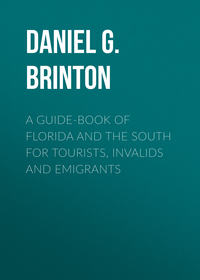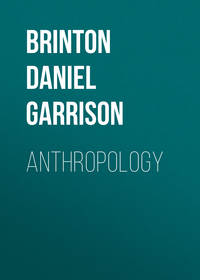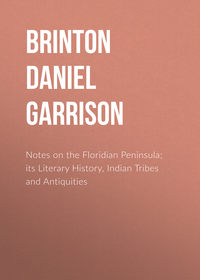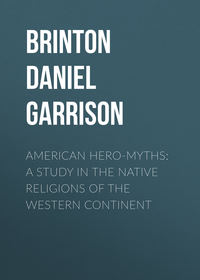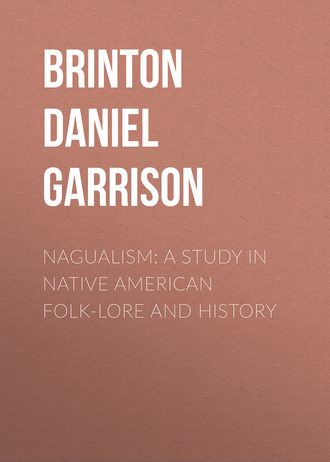 полная версия
полная версияNagualism: A Study in Native American Folk-lore and History
Next in importance to the assigning of names, according to Father Cordova, was the employment of the calendar in deciding the propriety of marriages. As the recognized object of marriage was to have sons, the couple appealed to the professional augur to decide this question before the marriage was fixed. He selected as many beans as was the sum of the numbers of the two proponents’ names, and, counting them by twos, if one remained over, it meant a son; then counting by threes any remainder also meant sons; by fours the remainder meant either sons or daughters; and by five and six the same; and if there was no remainder by any of these five divisors the marriage would result in no sons and was prohibited.
It is obvious that this method of fortune-telling was most auspicious for the lovers; for I doubt if there is any combination of two numbers below fourteen which is divisible by two, three, four, five and six without remainder in any one instance.32
The Zapotecs were one of those nations who voluntarily submitted themselves to the Spaniards, not out of love for the Europeans, but through hatred of the Aztecs, who had conquered them in the preceding century. Their king, Coyopy, and his subjects accepted Christianity and were generally baptized; but it was the merest formality, and years afterwards Coyopy was detected secretly conducting the heathen ritual of his ancestors with all due pomp. He was arrested, sent to the city of Mexico, deprived of his power and wealth, and soon died; it is charitably supposed, from natural causes. There is no question but that he left successors to the office of pontifex maximus, and that they continued the native religious ceremonies.
12. The sparse notices we have of the astrology of the Mixtecs, neighbors and some think relatives of the Zapotecs, reveal closely similar rites. The name of their king, who opposed Montezuma the First some sixty years before the arrival of Cortez, proves that they made use of the same or a similar calendar in bestowing personal appellations. It is given as Tres Micos, Three Monkeys.
Unfortunately, so far as I know, there has not been published, and perhaps there does not exist, an authentic copy of the Mixtec calendar. It was nevertheless reduced to writing in the native tongue after the conquest, and a copy of it was seen by the historian Burgoa in the Mixtec town of Yanhuitlan.33 Each day was named from a tree, a plant or an animal, and from them the individual received his names, as Four Lions, Five Roses, etc. (examples given by Herrera). This latter writer adds that the name was assigned by the priests when the child was seven years old (as among the Tzentals), part of the rite being to conduct it to the temple and bore its ears. He refers also to their auguries relating to marriage.34 These appear to have been different from among the Zapotecs. It was necessary that the youth should have a name bearing a higher number than that of the maiden, and also “that they should be related;” probably this applied only to certain formal marriages of the rulers which were obliged to be within the same gens.
13. I have referred in some detail to the rites and superstitions connected with the Calendar because they are all essential parts of Nagualism, carried on far into Christian times by the priests of this secret cult, as was fully recognized by the Catholic clergy. Wherever this calendar was in use, the Freemasonry of Nagualism extended, and its ritual had constant reference to it. Our fullest information about it does not come from central Mexico, but further south, in the region occupied by the various branches of the Mayan stock, by the ancestors of some one of which, perhaps, this singular calendar, and the symbolism connected with it, were invented.
One of the most important older authorities on this subject is Francisco Nuñez de la Vega, a learned Dominican, who was appointed Bishop of Chiapas and Soconusco in 1687, and who published at Rome, in 1702, a stately folio entitled “Constituciones Diœcesanas del Obispado de Chiappa,” comprising discussions of the articles of religion and a series of pastoral letters. The subject of Nagualism is referred to in many passages, and the ninth Pastoral Letter is devoted to it. As this book is one of extreme rarity, I shall make rather lengthy extracts from it, taking the liberty of condensing the scholastic prolixity of the author, and omitting his professional admonitions to the wicked.
He begins his references to it in several passages of his Introduction or Preambulo, in which he makes some interesting statements as to the use to which the natives put their newly-acquired knowledge of writing, while at the same time they had evidently not forgotten the ancient method of recording ideas invented by their ancestors.
The Bishop writes:
“The Indians of New Spain retain all the errors of their time of heathenism preserved in certain writings in their own languages, explaining by abbreviated characters and by figures painted in a secret cypher35 the places, provinces and names of their early rulers, the animals, stars and elements which they worshiped, the ceremonies and sacrifices which they observed, and the years, months and days by which they predicted the fortunes of children at birth, and assign them that which they call the Naguals. These writings are known as Repertories or Calendars, and they are also used to discover articles lost or stolen, and to effect cures of diseases. Some have a wheel painted in them, like that of Pythagoras, described by the Venerable Bede; others portray a lake surrounded by the Naguals in the form of various animals. Some of the Nagualist Masters claim as their patron and ruler Cuchulchan, and they possessed a certain formula of prayer to him, written in the Popoluca tongue (which was called Baha in their time of heathenism), and which has been translated into Mexican.36
“Those who are selected to become the masters of these arts are taught from early childhood how to draw and paint these characters, and are obliged to learn by heart the formulas, and the names of the ancient Nagualists, and whatever else is included in these written documents, many of which we have held in our hands, and have heard them explained by such masters whom we had imprisoned for their guilt, and who had afterwards become converted and acknowledged their sins.”37
The Bishop made up his mind that extreme measures should be taken to eradicate these survivals of the ancient paganism in his diocese, and he therefore promulgated the following order in the year 1692:
“And because in the provinces of our diocese those Indians who are Nagualists adore their naguals, and look upon them as gods, and by their aid believe that they can foretell the future, discover hidden treasures, and fulfill their dishonest desires: we, therefore, prescribe and command that in every town an ecclesiastical prison shall be constructed at the expense of the church, and that it be provided with fetters and stocks (con grillos y cepos), and we confer authority on every priest and curate of a parish to imprison in these gaols whoever is guilty of disrespect toward our Holy Faith, and we enjoin them to treat with especial severity those who teach the doctrines of Nagualism (y con rigor mayor á los dogmatizantes Nagualistas).”38
In spite of these injunctions it is evident that he failed to destroy the seeds of what he esteemed this dangerous heresy in the parishes of his diocese; for his ninth Pastoral Letter, in which he exposes at length the character of Nagualism, is dated from the metropolitan city of Ciudad Real, on May 24, 1698. As much of it is germane to my theme, I translate as follows:
“There are certain bad Christians of both sexes who do not hesitate to follow the school of the Devil, and to occupy themselves with evil arts, divinations, sorceries, conjuring, enchantments, fortune-telling, and other means to forecast the future.
“These are those who in all the provinces of New Spain are known by the name of Nagualists. They pretend that the birth of men is regulated by the course and movements of stars and planets, and by observing the time of day and the months in which a child is born, they prognosticate its condition and the events, prosperous or otherwise, of its life; and the worst is that these perverse men have written down their signs and rules, and thus deceive the erring and ignorant.
“These Nagualists practice their arts by means of Repertories and superstitious Calendars, where are represented under their proper names all the Naguals of stars, elements, birds, fishes, brute beasts and dumb animals; with a vain note of days and months, so that they can announce which corresponds to the day of birth of the infant. This is preceded by some diabolical ceremonies, after which they designate the field or other spot, where, after seven years shall have elapsed, the Nagual will appear to ratify the bargain. As the time approaches, they instruct the child to deny God and His Blessed Mother, and warn him to have no fear, and not to make the sign of the cross. He is told to embrace his Nagual tenderly, which, by some diabolical art, presents itself in an affectionate manner even though it be a ferocious beast, like a lion or a tiger. Thus, with infernal cunning they persuade him that this Nagual is an angel of God, who will look after him and protect him in his after life.
“To such diabolical masters the intelligent Indians apply, to learn from these superstitious Calendars, dictated by the Devil, their own fortunes, and the Naguals which will be assigned to their children, even before they are baptized. In most of the Calendars, the seventh sign is the figure of a man and a snake, which they call Cuchulchan. The masters have explained it as a snake with feathers which moves in the water. This sign corresponds with Mexzichuaut, which means Cloudy Serpent, or, of the clouds.39 The people also consult them in order to work injury on their enemies, taking the lives of many through such devilish artifices, and committing unspeakable atrocities.
“Worse even than these are those who wander about as physicians or healers; who are none such, but magicians, enchanters, and sorcerers, who, while pretending to cure, kill whom they will. They apply their medicines by blowing on the patient, and by the use of infernal words; learned by heart by those who cannot read or write; and received in writing from their masters by those acquainted with letters. The Master never imparts this instruction to a single disciple, but always to three at a time, so that in the practice of the art it may be difficult to decide which one exerts the magical power. They blow on feathers, or sticks, or plants, and place them in the paths where they may be stepped on by those they wish to injure, thus causing chills, fevers, ugly pustules and other diseases; or they introduce into the body by such arts toads, frogs, snakes, centipedes, etc, causing great torments. And by these same breathings and magic words they can burn down houses, destroy the growing crops and induce sickness. No one of the three disciples is permitted to practice any of these arts without previously informing the other two, and also the Master, by whom the three have been taught.
“We have learned by the confession of certain guilty parties how the Master begins to instruct his disciple. First he tells him to abjure God, the saints and the Virgin, not to invoke their names, and to have no fear of them. He then conducts him to the wood, glen, cave or field where the pact with the Devil is concluded, which they call ‘the agreement’ or ‘the word given’ (in Tzental quiz). In some provinces the disciple is laid on an ant-hill, and the Master standing above him calls forth a snake, colored with black, white and red, which is known as ‘the ant-mother’ (in Tzental zmezquiz).40 This comes accompanied by the ants and other small snakes of the same kind, which enter at the joints of the fingers, beginning with the left hand, and coming out at the joints of the right hand, and also by the ears and the nose; while the great snake enters the body with a leap and emerges at its posterior vent. Afterwards the disciple meets a dragon vomiting fire, which swallows him entire and ejects him posteriorly. Then the Master declares he may be admitted, and asks him to select the herbs with which he will conjure, the disciple names them, the Master gathers them and delivers them to him, and then teaches him the sacred words.
“These words and ceremonies are substantially the same in all the provinces. The healer enters the house of the invalid, asks about the sickness, lays his hand on the suffering part, and then leaves, promising to return on the day following. At the next visit he brings with him some herbs which he chews or mashes with a little water and applies to the part. Then he repeats the Pater Noster, the Ave, the Credo and the Salve and blows upon the seat of disease, afterwards pronouncing the magical words taught him by his master. He continues blowing in this manner, inhaling and exhaling, repeating under his breath these magical expressions, which are powerful to kill or to cure as he chooses, through the compact he has made with the Devil. Finally, so as to deceive the bystanders, he ends with saying in a loud voice: ‘God the Father, God the Son, and God the Holy Ghost. Amen.’
“This physician or healer is called in the towns of some of the provinces poxta vanegs, and the medicine gspoxil; and everything relating to healing among the Indians to which they apply these terms means also to practice sorcery; and all words derived from pox allude to the Nagual; for this in some provinces is called poxlon, and in others patzlan, and in many tzihuizin, which is something very much feared by the Indians. We have ascertained by the confessions of many who have been reconciled that the Devil at times appears to them in the shape of a ball or globe of fire in the air, with a tail like a comet.41
“According to the most ancient traditions of these Indians this idol, poxlon, was one of the most important and venerated they had in the old times, and the Tzentals revered it so much that they preserved it innumerable years painted on a tablet in the above figure. Even after they were converted to the faith, they hung it behind a beam in the church of the town of Oxchuc, accompanied by an image of their god Hicalahau, having a ferocious black face with the members of a man,42 along with five owls and vultures. By divine interposition, we discovered these on our second visit there in 1687, and had no little difficulty in getting them down, we reciting the creed, and the Indians constantly spitting as they executed our orders. These objects were publicly burned in the plaza.
“In other parts they reverence the bones of the earlier Nagualists, preserving them in caves, where they adorn them with flowers and burn copal before them. We have discovered some of these and burned them, hoping to root out and put a stop to such evil ceremonies of the infernal sect of the Nagualists.
“At present, all are not so subject to the promptings of the Devil as formerly, but there are still some so closely allied to him that they transform themselves into tigers, lions, bulls, flashes of light and globes of fire. We can say from the declaration and solemn confession of some penitents that it is proved that the Devil had carnal relations with them, both as incubus and succubus, approaching them in the form of their Nagual; and there was one woman who remained in the forest a week with the demon in the form of her Nagual, acting toward him as does an infatuated woman toward her lover (como pudiera con su proprio amigo una muger amancebada). As a punishment for such horrible crimes our Lord has permitted that they lose their life as soon as their Nagual is killed; and that they bear on their own bodies the wound or mark of the blow which killed it; as the curas of Chamula, Copainala and other places have assured us.
“The devilish seed of this Nagualism has rooted itself in the very flesh and blood of these Indians. It perseveres in their hearts through the instructions of the masters of the sect, and there is scarcely a town in these provinces in which it has not been introduced. It is a superstitious idolatry, full of monstrous incests, sodomies and detestable bestialities.”
Such are the words of the Bishop of Chiapas. We learn from his thoroughly instructed and unimpeachable testimony that at the beginning of the eighteenth century Nagualism was a widespread and active institution among the Indians of southern Mexico; that it was taught and practiced by professors who were so much feared and respected that, as he tells us in another passage, they were called “masters of the towns;”43 that they gave systematic instruction to disciples in classes of three, all of whom were bound together by pledges of mutual information and assistance; that a fundamental principle of the organization and an indispensable step in the initiation into its mysteries was the abjuration of the Christian religion, and an undying hatred to its teachers and all others of the race of the white oppressors; and that when they made use of Christian phrases or ceremonies it was either in derision or out of hypocrisy, the better to conceal their real sentiments.
There are a number of other witnesses from the seventeenth century that may be summoned to strengthen this testimony, if it needs it.
14. In the History of Guatemala, written about 1690 by Francisco Antonio Fuentes y Guzman, the author gives some information about a sorcerer of this school, who was arrested in Totonicapan, and with whom the historian had something to do as corregidor.
The redoubtable magician was a little old man, viejezuelo, and when caught had in his possession a document giving the days of the year according to the European calendar, with the Nagual, which belonged to each one. That for January is alone given by our writer, but it is probable that the other months merely repeated the naguals corresponding to the numbers. It ran as follows:
Nagual Calendar for January1. Lion2. Snake3. Stone4. Alligator5. Ceiba tree6. The quetzal (a bird)7. A stick8. Rabbit9. A rope10. Leaf11. Deer12. Guacamayo (parrot)13. Flower14. Toad15. Caterpillar16. A chip17. Arrow18. Broom19. Jaguar20. Corn-husk21. A flute22. Green-stone23. Crow24. Fire25. A pheasant26. A reed27. Opossum28. Huracan (the thunder-storm)29. The vulture30. Hawk31. BatWhen the sorcerer was examined as to the manner of assigning the proper nagual to a child he gave the following account:
Having been informed of its day of birth, he in due time called at the residence of the parents, and told the mother to bring the child into the field behind the house. Having there invoked the demon, the nagual of the child would appear under the form of the animal or object set opposite its birthday in the calendar, a serpent were it born on the 2d of January, a flower were it on the 13th, fire were it on the 24th, and so on. The sorcerer then addressed certain prayers to the nagual to protect the little one, and told the mother to take it daily to the same spot, where its nagual would appear to it, and would finally accompany it through all its life. Some, but not all, obtained the power of transforming themselves into the nagual, and the author declares that, though he could not cite such a case from his own experience, his father knew of several, and reliable priests, religiosos de fé, had told him enough examples to fill volumes.44
The tribes to which this author refers were the Cakchiquels and Quiches, who spoke practically the same tongue. An examination of some of the old dictionaries prepared by the early missionaries furnishes further and interesting information about this obscure subject.
In the Cakchiquel language of Guatemala, the word naual was applied both to the magician himself, to his necromantic art, and to the demonic agency which taught and protected him. This is shown by the following explanation, which I quote from Father Coto’s Vocabulario de la Lengua Cakchiquel, 1651, a manuscript in the library of the American Philosophical Society:
“Magic or Necromancy: puz or naual; and they were accustomed to call their magicians or sorcerers by the same terms. It was a kind of magic which they invoked in order to transform themselves into eagles, lions, tigers, etc. Thus, they said, ru puz, ru naual, pedro læ cot, balam, ‘Peter’s power, his naual, is a lion, a tiger.’ They also applied the words puz and naual to certain trees, rocks and other inanimate objects, whence the Devil used to speak to them, and likewise to the idols which they worshiped, as gazlic che, gazlic abah, huyu, k’o ru naual, ‘The life of the tree, the life of the stone, of the hill, is its naual,’ etc.; because they believed there was life in these objects. They used to have armies and soldiery to guard their lands, and the captains, as well as many who were not captains, had their nauales. They called the captain ru g’ alache; rohobachi, ti ru gaah, ru pocob, ru gh’ amay a ghay ti be chi naualil [he works magic with his shield, his lance, and his arrows].
“To practice such magical arts: tin naualih (‘I practice magic’), an active verb. They use it, for instance, when a man asks his wife for something to eat or drink, and she has nothing, owing to his negligence, she will say: ‘Where do you suppose I can get what you want? Do you expect me to perform miracles —xa pe ri tin naualih– that they shall come to my hands?’ So when one is asked to lend or give something which he has not, he will exclaim: Tin naualih pe ri puvak, etc. (‘Can I perform miracles,’ etc.)
“It also signifies to pretend something, concealing the truth, as xa ru naualim ara neh chu g’ ux ri tzih tan tu bijh pedro, ‘Peter is feigning this which he is saying.’ They are also accustomed to apply this word to the power which the priests exert (in the sacraments, etc.).”
A long and foolish account of the witchcraft supposed to be practiced among the Pokonchis of Guatemala, also a tribe of Mayan stock, is given by the Englishman, Thomas Gage, who was cura of a parish among them about 1630, and afterwards returned to England and Protestantism. He described, at wearisome length, the supposed metamorphosis of two chiefs of neighboring tribes, the one into a lion, the other into a tiger, and the mortal combat in which they engaged, resulting in the death of one to whom Gage administered absolution. No doubt he had been worsted in a personal encounter with his old enemy, and, being a man of eighty years, had not the vigor to recover. The account is of interest only as proving that the same superstitions at that time prevailed among the Pokonchis as in other portions of Guatemala.45
15. A really mighty nagualist was not confined to a single transformation. He could take on many and varied figures. One such is described in the sacred books of the Quiches of Guatemala, that document known by the name of the Popol Vuh, or National Book. The passage is in reference to one of their great kings and powerful magicians, Gucumatz by name. It says:
“Truly he was a wonderful king. Every seven days he ascended to the sky, and every seven days he followed the path to the abode of the dead; every seven days he put on the nature of a serpent, and then he became truly a serpent; every seven days he assumed the nature of an eagle, and then he became truly an eagle; then of a tiger and he became truly a tiger; then of coagulated blood, and he was nothing else than coagulated blood.”46
It may be said that such passages refer metaphorically to the versatility of his character, but even if this is so, the metaphors are drawn from the universal belief in Nagualism which then prevailed, and they do not express it too strongly.
16. Among the Maya tribes of Yucatan and Guatemala we have testimony to the continuance to this day of these beliefs. Father Bartolomé de Baeza, cura of Yaxcaba in the first half of this century, reports that an old man, in his dying confession, declared that by diabolical art he had transformed himself into an animal, doubtless his nagual; and a young girl of some twelve years confessed that she had been transformed into a bird by the witches, and in one of her nocturnal flights had rested on the roof of the very house in which the good priest resided, which was some two leagues from her home. He wisely suggests that, perhaps, listening to some tale of sorcery, she had had a vivid dream, in which she seemed to take this flight. It is obvious, however, from his account, as well as from other sources, that the belief of the transformation into lower animals was and is one familiar to the superstitions of the Mayas.47 The natives still continue to propitiate the ancient gods of the harvest, at the beginning of the season assembling at a ceremony called by the Spaniards the misa milpera, or “field mass,” and by themselves ti’ch, “the stretching out of the hands.”






